2023 HONDA CIVIC Driving
[x] Cancel search: DrivingPage 738 of 840
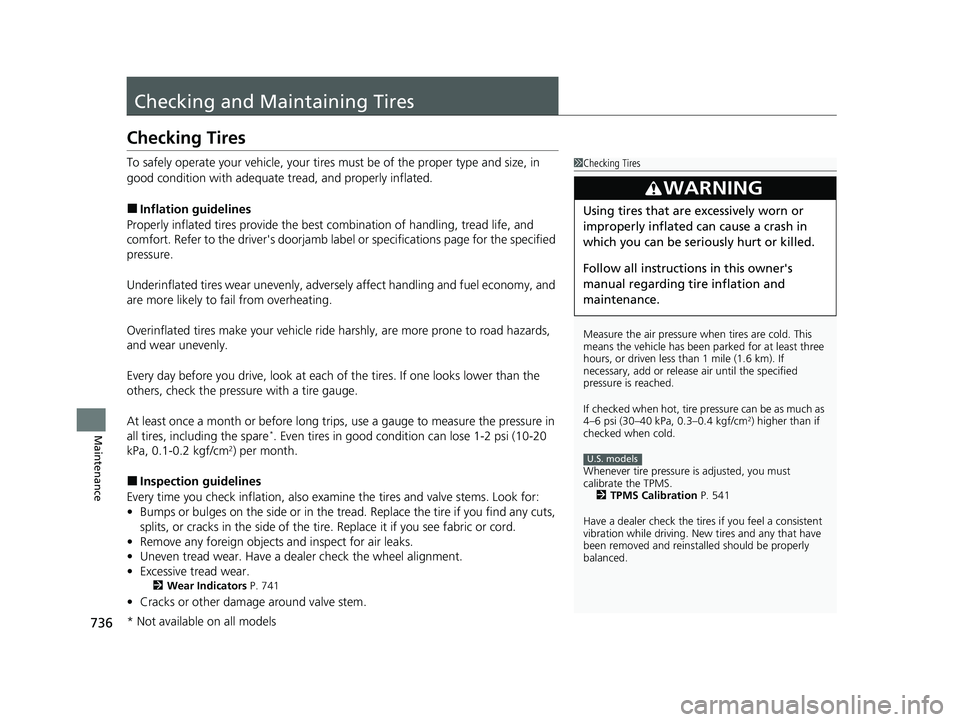
736
Maintenance
Checking and Maintaining Tires
Checking Tires
To safely operate your vehicle, your tires must be of the proper type and size, in
good condition with adequate tread, and properly inflated.
■Inflation guidelines
Properly inflated tires provide the best combination of handling, tread life, and
comfort. Refer to the driver's doorjamb labe l or specifications page for the specified
pressure.
Underinflated tires wear unevenly, adversely affect handling and fuel economy, and
are more likely to fail from overheating.
Overinflated tires make your vehicle ride harshly, are more prone to road hazards,
and wear unevenly.
Every day before you drive, look at each of the tires. If one looks lower than the
others, check the pressure with a tire gauge.
At least once a month or before long trips, use a gauge to measure the pressure in
all tires, including the spare
*. Even tires in good condition can lose 1-2 psi (10-20
kPa, 0.1-0.2 kgf/cm2) per month.
■Inspection guidelines
Every time you check inflation, also examine the tires and valve stems. Look for:
• Bumps or bulges on the side or in the tread . Replace the tire if you find any cuts,
splits, or cracks in the si de of the tire. Replace it if you see fabric or cord.
• Remove any foreign objects and inspect for air leaks.
• Uneven tread wear. Have a deal er check the wheel alignment.
• Excessive tread wear.
2 Wear Indicators P. 741
•Cracks or other damage around valve stem.
1Checking Tires
Measure the air pressure when tires are cold. This
means the vehicle has been parked for at least three
hours, or driven less than 1 mile (1.6 km). If
necessary, add or releas e air until the specified
pressure is reached.
If checked when hot, tire pressure can be as much as
4–6 psi (30–40 kPa, 0.3–0.4 kgf/cm
2) higher than if
checked when cold.
Whenever tire pressure is adjusted, you must
calibrate the TPMS. 2 TPMS Calibration P. 541
Have a dealer check the tires if you feel a consistent
vibration while driving. Ne w tires and any that have
been removed and reinst alled should be properly
balanced.
3WARNING
Using tires that are excessively worn or
improperly inflated can cause a crash in
which you can be seriously hurt or killed.
Follow all instruction s in this owner's
manual regarding ti re inflation and
maintenance.
U.S. models
* Not available on all models
23 CIVIC HATCHBACK TYPE R-31T406100_03.book 736 ページ 2022年6月23日 木曜日 午後9時28分
Page 741 of 840

739
uuChecking and Maintaining Tires uDOT Tire Quality Grading (U.S. Vehicles)
Continued
Maintenance
DOT Tire Quality Grading (U.S. Vehicles)
The tires on your vehicle m eet all U.S. Federal Safety
Requirements. All tires are also graded for treadwear, traction,
and temperature performance according to Department of
Transportation (DOT) standards. The following explains these
gradings.
Quality grades can be found where applicable on th e tire sidewall
between tread shoulder and maximum section width.
The treadwear grade is a comparative rating based on the wear
rate of the tire when tested un der controlled conditions on a
specified government test course. For example, a tire graded 150
would wear one and one-half (1 1/2) times as well on the
government course as a tire graded 100. The relative performance
of tires depends upon the actual conditions of their use, however,
and may depart significantly from the norm due to variations in
driving habits, service practi ces and differences in road
characteristics and climate.
■Uniform Tire Quality Grading
■Treadwear
1 Uniform Tire Quality Grading
For example:
Treadwear 200
Traction AA
Temperature A
All passenger car tires must conform
to Federal Safety Requirements in
addition to these grades.
23 CIVIC HATCHBACK TYPE R-31T406100_03.book 739 ページ 2022年6月23日 木曜日 午後9時28分
Page 743 of 840
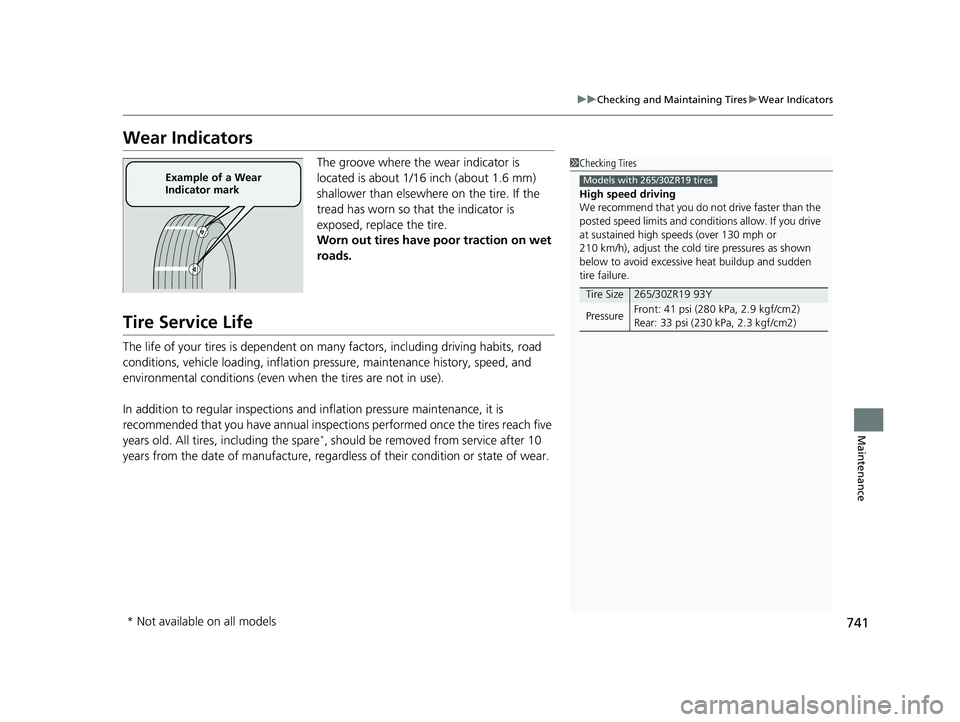
741
uuChecking and Maintaining Tires uWear Indicators
Maintenance
Wear Indicators
The groove where the wear indicator is
located is about 1/16 inch (about 1.6 mm)
shallower than elsewher e on the tire. If the
tread has worn so th at the indicator is
exposed, replace the tire.
Worn out tires have po or traction on wet
roads.
Tire Service Life
The life of your tires is dependent on many factors, including driving habits, road
conditions, vehicle loading, inflation pressure, maintenance history, speed, and
environmental conditions (even wh en the tires are not in use).
In addition to regular inspections and inflation pressure maintenance, it is
recommended that you have annual inspections performed once the tires reach five
years old. All tires, including the spare
*, should be removed from service after 10
years from the date of manufacture, regardle ss of their condition or state of wear.
1Checking Tires
High speed driving
We recommend that you do not drive faster than the
posted speed limits and conditions allow. If you drive
at sustained high speeds (over 130 mph or
210 km/h), adjust the cold tire pressures as shown
below to avoid excessiv e heat buildup and sudden
tire failure.
Tire Size265/30ZR19 93Y
Pressure Front: 41 psi (280 kPa, 2.9 kgf/cm2)
Rear: 33 psi (230 kPa, 2.3 kgf/cm2)
Models with 265/30ZR19 tiresExample of a Wear
Indicator mark
* Not available on all models
23 CIVIC HATCHBACK TYPE R-31T406100_03.book 741 ページ 2022年6月23日 木曜日 午後9時28分
Page 746 of 840
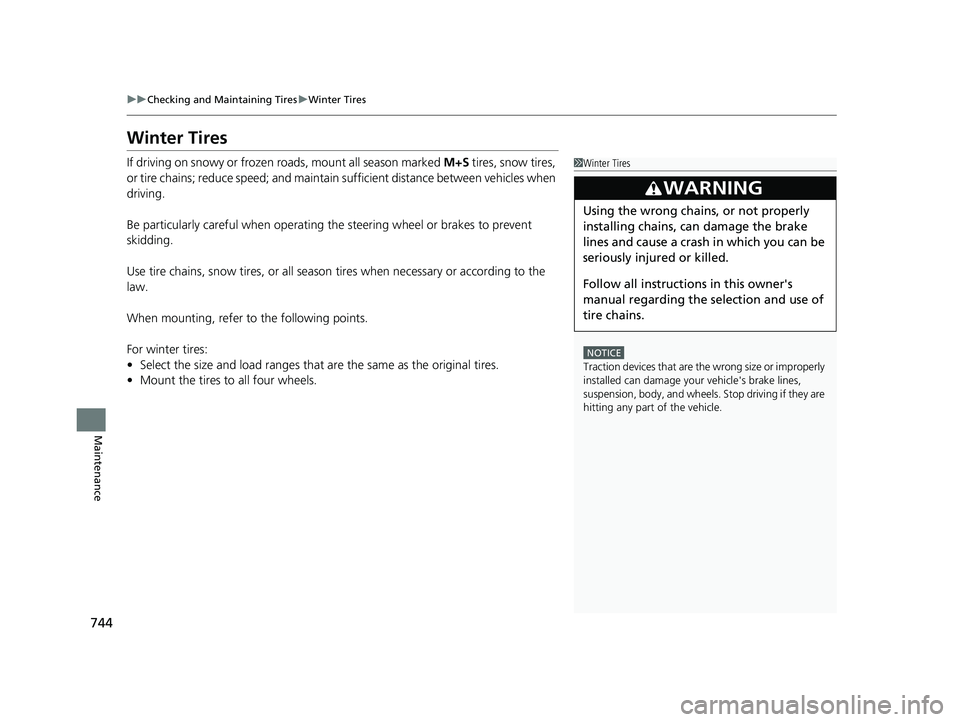
744
uuChecking and Maintaining Tires uWinter Tires
Maintenance
Winter Tires
If driving on snowy or frozen roads, mount all season marked M+S tires, snow tires,
or tire chains; reduce speed; and maintain sufficient distance between vehicles when
driving.
Be particularly careful when operating the steering wheel or brakes to prevent
skidding.
Use tire chains, snow tires, or all season tires when necessary or according to the
law.
When mounting, refer to the following points.
For winter tires:
• Select the size and load ranges that are the same as the original tires.
• Mount the tires to all four wheels.1Winter Tires
NOTICE
Traction devices that are the wrong size or improperly
installed can damage your vehicle's brake lines,
suspension, body, and wheels. Stop driving if they are
hitting any part of the vehicle.
3WARNING
Using the wrong chains, or not properly
installing chains, can damage the brake
lines and cause a crash in which you can be
seriously injured or killed.
Follow all instruction s in this owner's
manual regarding the selection and use of
tire chains.
23 CIVIC HATCHBACK TYPE R-31T406100_03.book 744 ページ 2022年6月23日 木曜日 午後9時28分
Page 747 of 840

745
uuChecking and Maintaining Tires uWinter Tires
Maintenance
For tire chains:
• Install them on the front tires only.
• Because your vehicle has limited tire clea rance, we strongly recommend using the
chains listed below:
• Follow the chain manufactur er's instruction when installing. Mount them as
tightly as you can.
• Check that the chains do not touch the brake lines or suspension.
• Drive slowly.
Cable-type: SCC Radial Chain SC1032
Cable-type: SCC Radial Chain SC1032
Cable-type: SCC Radial Chain SC1034
Not recommended to use any type of chain or cable
1Winter Tires
When tire chains are mounted, follow the chain
manufacturer's instructi ons regarding vehicle
operational limits.
If your vehicle is equipp ed with summer tires, be
aware that these tires are not designed for winter
driving conditions. For more information, contact a
dealer.
Models with 215/55R16 tires
Models with 215/50R17 tires
Models with 235/40R18 tires
Models with 265/30ZR19 tires
23 CIVIC HATCHBACK TYPE R-31T406100_03.book 745 ページ 2022年6月23日 木曜日 午後9時28分
Page 748 of 840
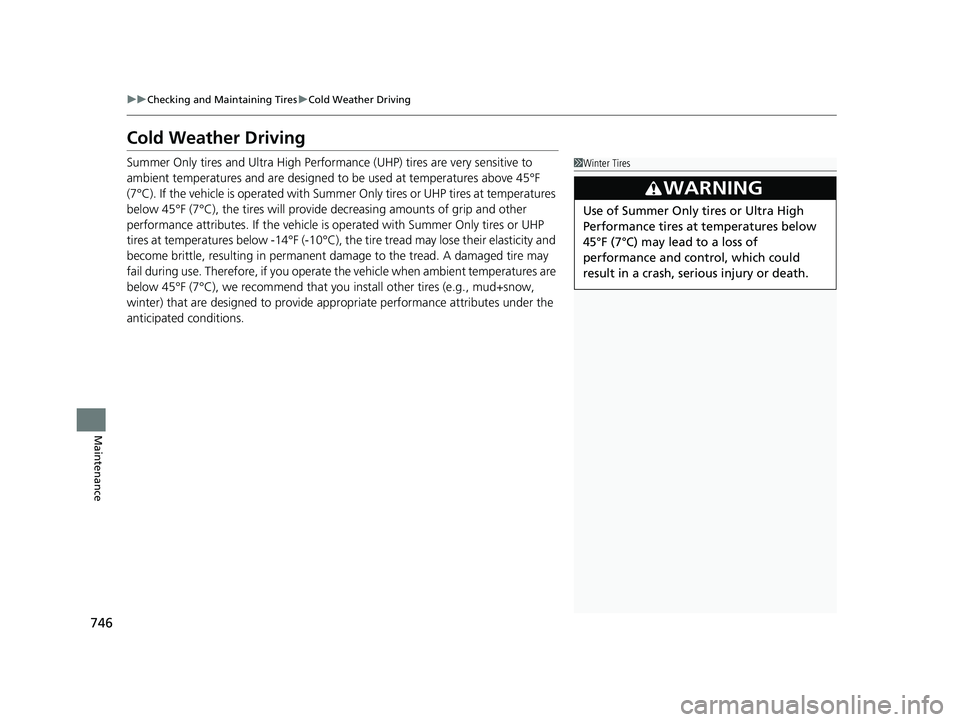
746
uuChecking and Maintaining Tires uCold Weather Driving
Maintenance
Cold Weather Driving
Summer Only tires and Ultra High Performan ce (UHP) tires are very sensitive to
ambient temperatures and are designed to be used at temperatures above 45°F
(7°C). If the vehicle is operated with Summer Only tires or UHP tires at temperatures
below 45°F (7°C), the tires will provide decreasing amounts of grip and other
performance attributes. If the vehicle is operated with Summer Only tires or UHP
tires at temperatures below -14°F (-10°C), the tire tread may lose their elasticity and
become brittle, resulting in permanent damage to the tread. A damaged tire may
fail during use. Therefore, if you operate the vehicle when ambient temperatures are
below 45°F (7°C), we recommend that you install other tires (e.g., mud+snow,
winter) that are designed to provide appropriate performance attributes under the
anticipated conditions.1 Winter Tires
3WARNING
Use of Summer Only tires or Ultra High
Performance tires at temperatures below
45°F (7°C) may lead to a loss of
performance and control, which could
result in a crash, se rious injury or death.
23 CIVIC HATCHBACK TYPE R-31T406100_03.book 746 ページ 2022年6月23日 木曜日 午後9時28分
Page 755 of 840
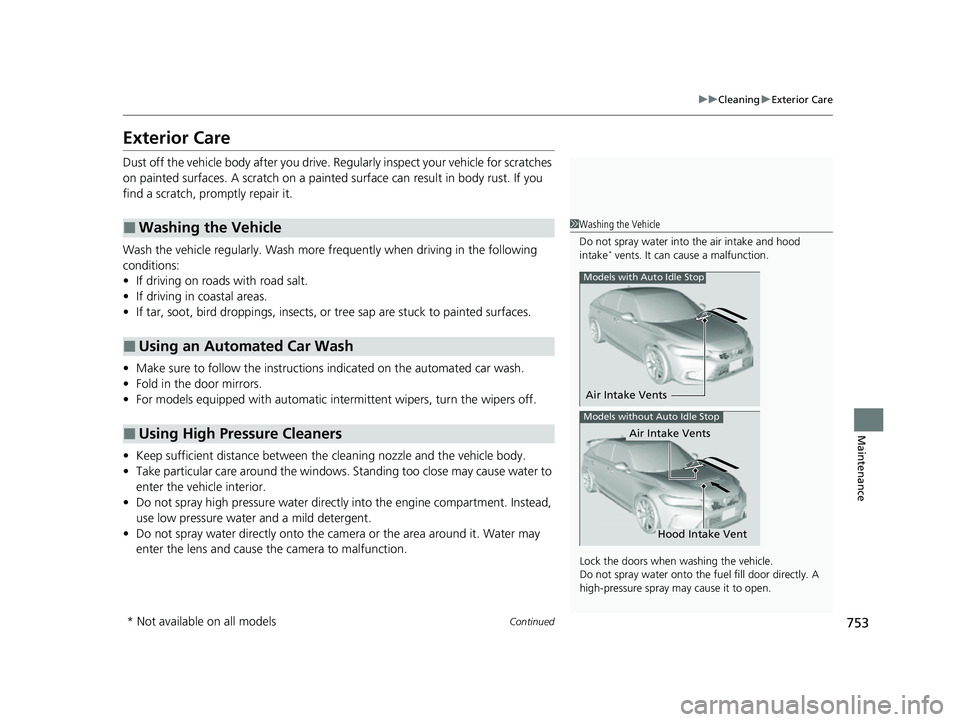
753
uuCleaning uExterior Care
Continued
Maintenance
Exterior Care
Dust off the vehicle body after you drive. Regularly inspect your vehicle for scratches
on painted surfaces. A scratch on a painted surface can result in body rust. If you
find a scratch, promptly repair it.
Wash the vehicle regularly. Wash more frequently when driving in the following
conditions:
• If driving on roads with road salt.
• If driving in coastal areas.
• If tar, soot, bird droppings, insects, or tree sap are stuck to painted surfaces.
• Make sure to follow the instructions indicated on the automated car wash.
• Fold in the door mirrors.
• For models equipped with automatic inte rmittent wipers, turn the wipers off.
• Keep sufficient distance between the cleaning nozzle and the vehicle body.
• Take particular care around the windows. Standing too close may cause water to
enter the vehicle interior.
• Do not spray high pressure water directly into the engine compartment. Instead,
use low pressure water and a mild detergent.
• Do not spray water directly onto the ca mera or the area around it. Water may
enter the lens and cause th e camera to malfunction.
■Washing the Vehicle
■Using an Automated Car Wash
■Using High Pressure Cleaners
1Washing the Vehicle
Do not spray water into the air intake and hood
intake
* vents. It can cause a malfunction.
Lock the doors when washing the vehicle.
Do not spray water onto the fuel fill door directly. A
high-pressure spray ma y cause it to open.
Air Intake Vents
Models with Auto Idle Stop
Models without Auto Idle Stop
Air Intake Vents
Hood Intake Vent
* Not available on all models
23 CIVIC HATCHBACK TYPE R-31T406100_03.book 753 ページ 2022年6月23日 木曜日 午後9時28分
Page 758 of 840
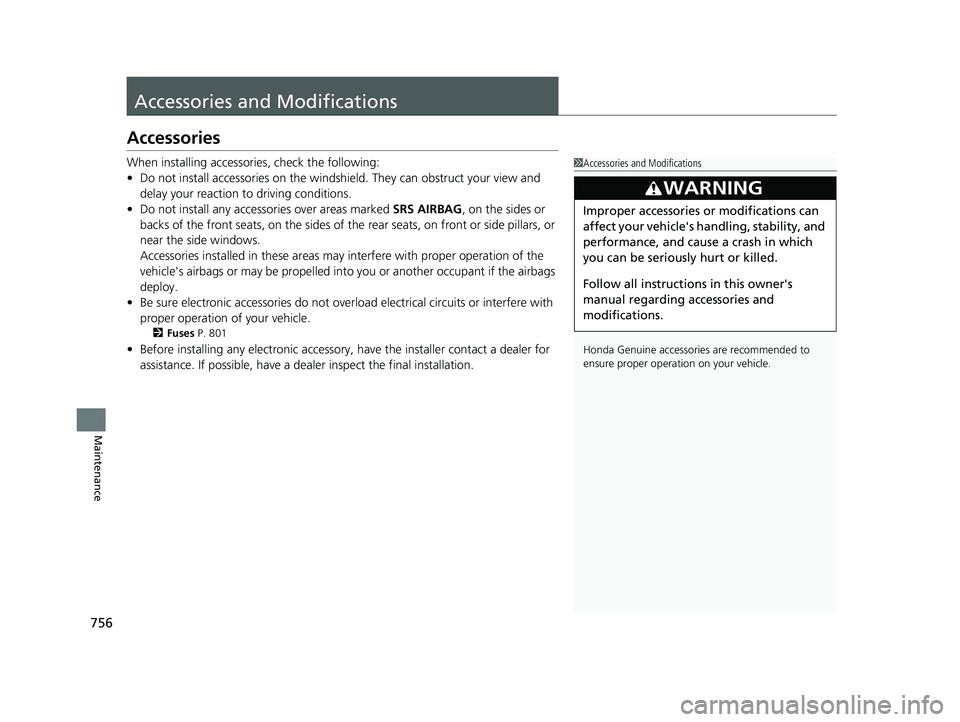
756
Maintenance
Accessories and Modifications
Accessories
When installing accessories, check the following:
• Do not install accessories on the windshield. They can obstruct your view and
delay your reaction to driving conditions.
• Do not install any access ories over areas marked SRS AIRBAG, on the sides or
backs of the front seats, on the sides of the rear seats, on front or side pillars, or
near the side windows.
Accessories installed in these areas may interfere with proper operation of the
vehicle's airbags or may be propelled into you or another occupant if the airbags
deploy.
• Be sure electronic accessories do not over load electrical circuits or interfere with
proper operation of your vehicle.
2 Fuses P. 801
•Before installing any electron ic accessory, have the installer contact a dealer for
assistance. If possible, have a d ealer inspect the final installation.
1Accessories and Modifications
Honda Genuine accessor ies are recommended to
ensure proper operati on on your vehicle.
3WARNING
Improper accessories or modifications can
affect your vehicle's handling, stability, and
performance, and cause a crash in which
you can be seriously hurt or killed.
Follow all instruction s in this owner's
manual regarding accessories and
modifications.
23 CIVIC HATCHBACK TYPE R-31T406100_03.book 756 ページ 2022年6月23日 木曜日 午後9時28分